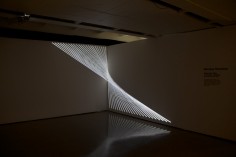Cuppetelli and Mendoza
Nervous Structure
source: highlike
Work: The Nervous Structure series consists of interactive installations that revolve around the idea of interface, interpreted as the point of contact between two different entities. The work consists of several such interfaces: between the viewer and the piece (a human/computer interface); between the real and the virtual (the physical structure and its relationship with the projected structure); between the foreground and the background (as the projection interferes with its shadow). The pieces consist of a soft structure made out of elastic or spandex and a projector that illuminates it with computer-generated graphics. Viewers interact with the piece by moving in the field of vision of a camera, which is connected to the computer; this motion is transformed by the software into forces that affect the projected lines.
Image: Courtesy of the artists
.
.
.
.
.
.
.
source: youtube
Nervous Structure is an interactive installation created by emerging artists Annica Cuppetelli (USA) and Cristobal Mendoza (Venezuela). The work is composed of hundreds of vertical elastic lines illuminated with interactive computer graphics that react to the presence and motion of viewers. The piece consists of three planes that intersect: the physical plane (the structure), the virtual plane (the projection) and the perceptual plane (the viewer and his/her interaction). The artists note that “it is in these various points of intersection that the piece works, and our interest lies in the perceptual problems that arise within these intersections.”
A significant aspect of the installation is the moiré pattern, which is created when the projected lines move over the structure. A moiré pattern is the optical result of two overlapping grids that are not in perfect alignment. The term is used widely in physics and computer graphics; however the word is hundreds of years old and originates from a type of textile that has a “watery” look, which is produced by layering fabric. The fact that so much of modern technology terminology has its origins in historical techniques (particularly in textiles) is of great interest to the artists, as it connects their individual practices and it ties their work to history.
Cuppetelli and Mendoza began their artistic collaboration in autumn 2010. They have exhibited in the Biennial of Video and Media Arts (Chile, 2012) and festivals such as Scopitone 2012 (France), ISEA 2012, FILE 2011 (Brazil), FAD 2011 (Brazil), video_dumbo 2011 (New York, NY) among others. Cuppetelli received her MFA from Cranbrook Academy of Art (Fibers, 2008) and Mendoza at the Rhode Island School of Design (Digital Media, 2007). Mendoza is an Assistant Professor in the Department of Art and Art History at Wayne State University in Detroit, MI, where they are based.
.
.
.
.
.
.
.
source: lipscomb
Annica Cuppetelli (USA) and Cristobal Mendoza (Venezuela) began their artistic collaboration in the fall of 2010. Their work features walls of vertical elastic fibers illuminated by video projectors. The movements of viewers are reflected through movement in the luminous fibers.
Work by Cuppetelli and Mendoza has been exhibited in the 2012 Biennial of Video and Media Arts in Chile and festivals such as Scopitone 2012 in France, ISEA 2012 in New Mexico, FILE 2011 and FAD 2011, both in Brazil, and video_dumbo 2011 in New York City, among others.
Cuppetelli obtained her MFA from Cranbrook Academy of Art in 2008 with a specialty in fibers, and Mendoza obtained his MFA at the Rhode Island School of Design in 2007 in digital media. Mendoza is an assistant professor in the Department of Art and Art History at Wayne State University in Detroit, Mich., where both artists are based.
.
.
.
.
.
.
.
source: archdaily
Nervous Structure (Estructura Nerviosa) nos muestra lo mejor de las cualidades de la luz como medio entre el humano y lo visual. Se trata de una instalación lumínica interactiva donde se combina una estructura física, hecha de spandex o cuerdas elásticas, y otra virtual, generada por una computadora y proyectada sobre la primera.
Al acercase el espectador, una cámara de video capta su imagen y traduce sus movimientos en fuerzas que afectan a la proyección a través de un sistema de simulación física.
Más información, después del Salto.
Hay dos conceptos principales en la pieza. El primero gira sobre la idea de “interfaz,” (interface en inglés) interpretada como el punto de contacto entre dos entes distintos, y en este caso esos entes son lo físico y lo virtual. En la pieza esa interfaz se ve reflejada en dos puntos: uno en el contacto entre la proyección y la estructura física y otro en la interacción del participante y la interpretación de sus movimientos (físicos) en fuerzas (virtuales) que afectan a la proyección.
.
.
.
.
.
.
.
source: sonore-visuel
Transposition, du duo Cuppetelli and Mendoza, est composée de 348 cordes élastiques fixées devant un écran sur lequel est projeté une animation cinétique générative sonore, qui ondule en fonction des mouvements du spectateur.
Le duo avait déjà présenté leur installation Transposition, mais en voici une nouvelle version sonore. Elle est composée de 348 cordes élastiques fixées devant un écran sur lequel est projeté une animation cinétique générative sonore. La vision conjuguée des deux plans provoquent un effet de moiré en mouvement. Le déplacement du spectacteur provoque l’ondulation des formes graphiques et le traitement en temps réel de la composition sonore.
.
.
.
.
.
.
.
source: cargocollective
Nervous Structure – Annica Cuppetelli and Cristobal Mendoza
Nervous Structure – серия интерактивных инсталляций и скульптур Анники Купетелли и Кристобаля Мендоса. Инсталляция обычно состоит из двух частей – физического объекта и программно генерируемой видеопроекции. При этом объект, как правило, дополняет архитектуру выставочного пространства, незаметно вписывается в него, а видеопроекция реагирует на движение зрителей и дополняет архитектуру объекта.


